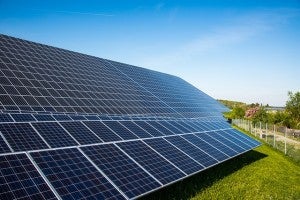Let’s Talk About Solar Power and Equity
By Jorge Madrid, Campaign Manager, Climate & Energy.
 We need to have “the talk” about solar power and equity, because ignoring uncomfortable questions will invite misinformation and bad decisions. We need an informed dialogue about how local solar power can impact low-income communities and communities of color in the U.S. We need to talk about “all the good things, and the bad things, that may be.”
We need to have “the talk” about solar power and equity, because ignoring uncomfortable questions will invite misinformation and bad decisions. We need an informed dialogue about how local solar power can impact low-income communities and communities of color in the U.S. We need to talk about “all the good things, and the bad things, that may be.”
First things first: the price of solar panels has fallen by 80 percent since 2008. This significant decrease in cost, coupled with incentives such as net metering which allow customers to send the energy they produce from their solar systems back to the grid and receive a credit on their bill, and the emergence of new financing models like solar “leasing” programs, has led to an explosion of local solar in the U.S.
We now boast an estimated 20 gigawatts of solar energy nationwide (enough to power more than four million U.S. homes), and the United States added more solar capacity in the past two years than in the previous 30 years combined. In fact, as President Obama highlighted in his State of the Union address, “every three weeks, we bring online as much solar power as we did in all of 2008.”
So, who is benefiting from this solar boom? In regard to rooftop solar, it is mostly middle-income and working class homeowners, according to analysis from the Center for American Progress:
“Rooftop solar is not just being adopted by the wealthy; it is, in fact, mostly being deployed in neighborhoods where median income ranges from $30,000 to $90,000.”
The growth of the solar industry is also creating good jobs, and plenty of them. The solar industry added jobs nearly 20 times faster than the national average in 2014, and solar employment has increased 86 percent in the past five years. Solar installers make an average of $20 to $24 per hour, and solar salespeople can make $30 to $60 per hour. And, as I have written before, solar and other clean energy jobs are generally more accessible to people of color and folks without advanced degrees.
Not to be overlooked are the environmental benefits of solar: the deployment of this clean energy resource helped avoid an estimated 20 million metric tons of harmful carbon dioxide emissions in 2014, the equivalent of taking four million cars off U.S. highways. The fact that solar averts dirty, fossil fuel pollution has a critical equity aspect, as approximately 68 percent of African Americans (and a similar percentage of Latinos) live within 30 miles of a coal-fired power plant, and a recent study claims that nearly 40 percent of communities of color breathe polluted air.
While all of this news is encouraging, there are still important questions about local solar access and affordability for low-income people, renters, and communities of color – constituencies that greatly overlap. [Tweet “We need an informed dialogue about how local solar power can impact low-income communities. http://ow.ly/JAG2J “]
There is no easy answer, but fortunately this issue has been a priority for many lawmakers and advocates – including Environmental Defense Fund – who are working to find solutions. A community solar pilot project in Los Angeles, for example, will empower residents to own a share of a local solar garden without installing panels on their own roofs. This has the potential to reach 51 percent of the population in L.A. who rent, and large swaths of residents who can’t afford their own solar system. These and other policies can create access and affordability for people who otherwise could not join the clean energy revolution – and we need to get these policies right.
But, in the meantime, we also need to counteract misinformation and bad ideas.
Enter the “solar hurts low income people” argument, which claims that low-income people are paying higher bills to subsidize solar power they can’t afford, and thus advocates and lawmakers should oppose it. This argument is misguided, ignores critical information, and often emanates from industry groups trying to turn low-income communities against clean energy.
To be clear, asking important questions regarding clean energy and equity is productive; so is pushing lawmakers to find solutions that work for all communities and don’t place unfair, burdensome costs on low-income people. What’s unproductive is misinformation and conjecture. To forge fair, lasting solutions, we need real, unbiased data and analysis on the costs of solar to customers and the grid, some of which already exists:
- Fact: a study commissioned by the California Public Utilities Commission found that solar customers on average cover their full costs to the electric grid;
- Fact: a study by the Nevada Public Utilities Commission and a study from the Mississippi Public Service Commission found that solar customers provide a net benefit to all ratepayers;
- Fact: an analysis from Deutsche Bank finds that rooftop solar will be as cheap as traditional power by 2016 in all 50 states (this is already happening in 11 states); and
- Fact: an analysis from the Lawrence Berkeley National Laboratory (LBNL) found that even the most aggressive net-metering solar programs would have minimal (0.1-2.7 percent) impact on electricity rates.
So, why would some industry groups want to slow the growth of local solar? (Spoiler alert: it’s about THE MONEY!) The LBNL study found that local solar will have significant impacts on utility shareholder profits – up to a 40 percent loss for some. It seems clear that the efforts to attack local solar may have more to do with threats to utility profits than negative impacts on low-income people.
And, thus, we arrive back where we started: let’s not decoy, avoid, or make void this topic. We need to ask complex and sometimes uncomfortable questions when it comes to local solar power and equity. It’s ok that we don’t have all the answers figured out ahead of time, as long as we learn together and arrive at solutions based on real information. But it’s not ok to allow misinformation and bad ideas to lead us to making the wrong decisions.











